Igniting Imagination
Empowering Communities 26 Art-based Reflections on Transformation

Igniting Imagination
Empowering Communities 26 Art-based Reflections on Transformation
Officer,



Ms Susanna Chau
DD/Music, STAR (till 15 December 2023)
Happy New Year and welcome to a brand-new academic year. I wish you a year of exciting new learning for yourself and your students.
In the previous STAR-Post (July 2023), I mentioned that we are living in the age of *The Jetsons* and urged us to rise to the challenge to embrace the rise of Generative AI and its affordances. Since TCEF2023, we have received more information on the EdTech Masterplan 2030 and the emerging 21CCs (E21CCs).
Generative AI – to some , it is a wonderful and exciting tool to have, and to others, it strikes fear (much like the 1st IT Masterplan in 1997). Most of us are exploring it and testing the potential it offers, but at the same time have some trepidations about it. Whichever group we are in, we will have questions such as these: How can we leverage it to enhance students’ learning experiences in the classroom? How can it help us in the work that we do? How will it impact the future of assessment and the way students learn?

Another topic brought up at TCEF2023 was that of the E21CCs, focusing on critical, adaptive and inventive thinking, as well as civic, global, and cross-cultural literacies. What aspects of these 21CCs spark our imagination and how may we ignite those of our students? How can we craft learning experiences to help our students develop critical, adaptive, and inventive thinking? How can we empower them as creators, connectors, and contributors? How can Music take lead in this?
Throughout this issue, some of these questions are discussed, and hopefully they provide us the impetus and dare to lead the change, forging fresh ways for our students to navigate the labyrinth of play and creativity in music. Some of our colleagues in the Music fraternity have generously shared their experiences and reflections on how they ignite students’ imagination, empower them to take charge of their own learning and contribute to their class and school communities. How could these inspire us to transform our own practice and learning environments?
Finally, we round off this issue with a summary of TCEF2023 highlights as well as the return of a physical FIC concert at the National Library.
By the time this issue is published, I would have ended my stint at STAR and reported to my next posting. Ms. Lee Ley Har would have assumed the role of DD/Music. Please continue to give her and the wonderful team of P/MTTs and ACOs your support. I thank all of you for your enthusiasm and active participation in the PD programmes that STAR offers. May you find much joy and satisfaction in the classes that you teach, and the students you encounter daily.
Take care and stay safe.

In Minister Chan Chun Sing’s opening speech at the Teachers’ Conference and ExCEL Fest (TCEF) 2023, he asked, “What are the key principles behind a successful education system?”. He agreed with the audience that teacher quality is one of the most important factors, and encouraged us to keep learning individually and collectively.
One area of growth he highlighted was leveraging technology to scale and customise learning. Some of us will remember the video of “Minister Chan’’ rapping about TCEF, which was created using five different types of AI tools. This served to demonstrate the prevalence of AI in the future of education, and prompted us to consider:
Despite AI’s many capabilities, Professor Diana Laurillard highlighted in her TCEF keynote that the strength of AI is not in its ability to personalise learning or design pedagogies, but to allow collaboration between teachers, students, and technologies as co-designers of learning.
In his TCEF keynote, Mr. Andreas Schleicher also shared that we are adept at educating our youth for the world today, but less so at creating aspirations for the future. Thus, Minister Chan noted that we need to help our students be ready to understand tomorrow’s challenges and find those solutions ahead of time. He asks,
Mr Schleicher shared that we need to help students develop a reliable compass to navigate the increasingly complex and volatile world with confidence. Minister Chan noted that all our academic learning rests on our values development; students’ competencies beyond academics need to run in parallel with their academic rigour and development. In his keynote, Professor James Arthur also reflects on the importance of intentionality in facilitating a participatory school ethos that contributes to students’ character development.
It is with these considerations in mind that we introduce the two key themes for this issue, which are aligned with TCEF 2023:
“Adaptive Thinking” is a new dimension introduced in the refreshed Framework for 21CC and Student Outcomes (2023). Creativity and imagination form the nexus of adaptive thinking (Tan & Ponnusamy, 2014), which may be interpreted as applied creative thinking as it creates new knowledge or adapts tasks in new ways (Maren, 2019; Schwartz et al., 2005).

Although AI can help us research and assimilate information, it cannot imagine. How then, can we ignite our students’ and our own imaginations?
Professor Pamela Burnard’s Spotlight offers new perspectives for how we can expand the boundaries of our creativity by affording greater recognition to the environment and tools around them.
Another area of focus in the revised 21CC Framework is “Civic, Global and Cross-Cultural Literacy”. This involves being open-minded and empathetic when interacting with culturally diverse groups. How can we empower schools and students as community builders? What lessons can we learn from community music in empowering communities?
Professor Lee Higgins’s Spotlight helps us better understand community music as an act of hospitality, paving the way for new possibilities through compassionate dialogues between participants.
The start of the year is perhaps a good time to take stock of how we envision the future of teaching and learning in the music classroom. In this issue, we will hear from our colleagues on how they seek to transform practice in order to ignite imagination in their students and in their work, and empower inclusive communities of practice. If any of these stories spark more ideas for you, please reach out to affirm them.
We wish you an enjoyable read!
Reflecting on the TCEF Spotlight by Professor Pamela Burnard (University of Cambridge, UK)
5-min read
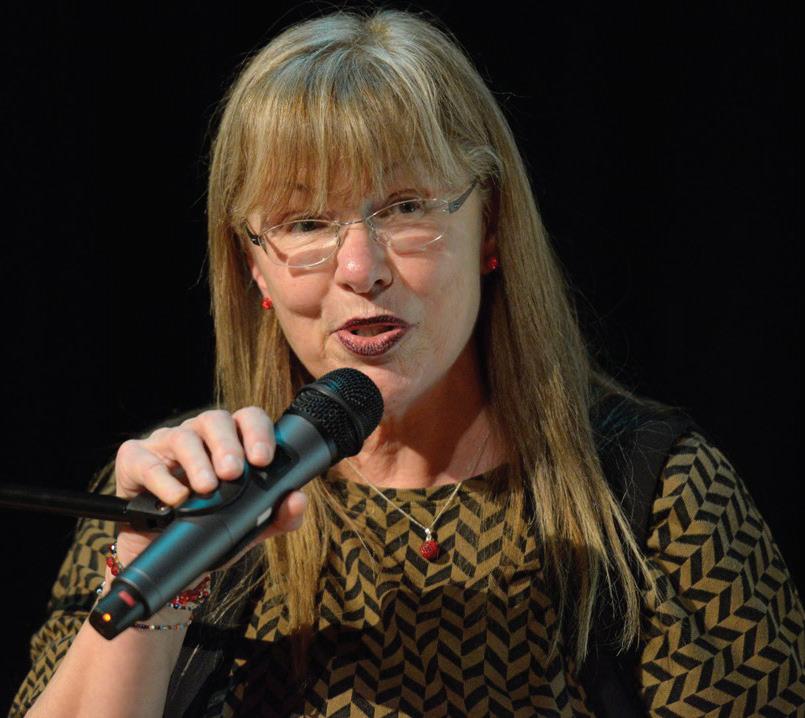
As musicians, tools are very important to us. The instruments we play, the hardware and software we use to create and listen to music, and the sheet music we refer to are all indispensable partners in our music-making processes. Contexts and spaces also influence how we make and listen to music. How can students be empowered to expand and develop their (musical) creativities by forming stronger partnerships with nonhuman entities?
In her Spotlight address, Dr Pamela Burnard shares about a posthumanist approach to creativity. This approach asks humans to decenter themselves from creative processes in order to recognise that the environment and tools around us have agency to impact us. Rather than the environment and tools around us being subservient to our needs, the posthumanist approach considers how places, spaces and objects can impact our thinking, our feelings and experiences, and hence impact teaching and learning. The approach offers transformative possibilities for teaching approaches as educators can adapt as they interact with their changing contexts.
Through this approach, humans can engage in intra-active dialogues with nonhuman entities, resulting in imagination being ignited to discover new creative ideas and diverse possibilities. Since creativity can empower ourselves and our learners.
The posthumanist approach could also be understood as an inclusive practice since it seeks to recognise and include different kinds of ‘voices’ as we decenter ourselves. Inclusion allows us to promote equitable opportunities for all individuals and value a variety of perspectives which will foster social cohesion, innovation and overall well-being. These help us respond to the global instabilities that surround us in the 21st century. This is something we see as well in Empowering Communities (p. 16), where Dr Lee Higgins discusses community music as an act of hospitality.
As a compassionate way of knowing, posthumanism also restores power imbalances in the classroom. It moves away from the teacher-centric assumption that adults play a dominant role in enabling students to become musically literate makers and consumers of music. This assumption overlooks the role that places, things, objects and atmospheres play in students’ ecologies.
Future-making education is the capacity to invent new visions of what should be and what might be in our society, homes, schools, and communities. Dr Burnard reminds us that considering the multiplicity of ways in which pedagogy and practice can be done differently involves vulnerability, passion, risk, mess, and difficulty. Let’s persevere through these difficulties together to maintain progress.
Questions:

• What are some examples of environments and tools we work with in music-making and in our daily work?
• How can we decenter ourselves to make more equal space for these environments and tools in creative processes?
• How can we encourage our students to do the same in their musical engagements?
Read on to find out how our teachers are igniting imagination in their work.
AI-generated graphic depicting collaborations between nature, technology, musical instrument, and human.
3-min read
What were our experiences as beginning teachers like?
For some of us, there may have been steep learning curves involved, but it was also a time of great creativity, inspiration, and above all, imagination.
• What were our beliefs about music education then?
• How did these beliefs inform our imaginations of the kind of musical experiences we wanted our students to have?
• And how did these imaginations drive us forward in our growth as music teachers?
In this article, our young teachers (≤ 5 years in service) share their aspirations to hone their teaching practices in order to enact their teacher beliefs
Lee Zi An Amos

I appreciate the need for my music lessons to reflect the current reality of the changing global landscape. In a globalised world, students need to work with people of other nationalities and cultures. Music acts as a gateway to other cultures of the world, and our lessons can enable students to learn about a palette of musical cultures through experiential, creative and enjoyable means. When I was in NIE, Dr Lum Chee Hoo’s lessons gave us insights on how students could learn to appreciate diverse music cultures through a variety of means, helping them develop certain social emotional competencies as they broaden their musical horizons.

I also see the importance of engaging students and not just feeding them content or focusing on hitting learning objectives alone, as probably much of what they would remember after leaving school would be their musical experiences. At the end of the day, I am not aiming to develop music prodigies through my music lessons but I hope to provide students with an enriching and holistic foundation for their lifelong involvement in the arts, specifically music. These are some ideals that guide me in my planning process when I think about my lessons for my students.

I love seeing a bustling class where students talk about how they can present their pop songs, experiment with sounds, come up with ideas, and make them work. These show that they have a genuine thirst for learning. Students take ownership of their own learning by asking questions and engaging in hands-on exploration, which fuels their imaginative and creative processes.
To facilitate such processes, I must be imaginative too. I need to have a bag full of “magic props”, be it using visual cards, casting students’ live performances through Apple TV, or making use of the coloured cards in students’ handbooks. I adopt, adapt, and improvise using these pedagogical props to support my students’ learning; I try to be flexible and creative, like a seasoned magician captivating the audiences!
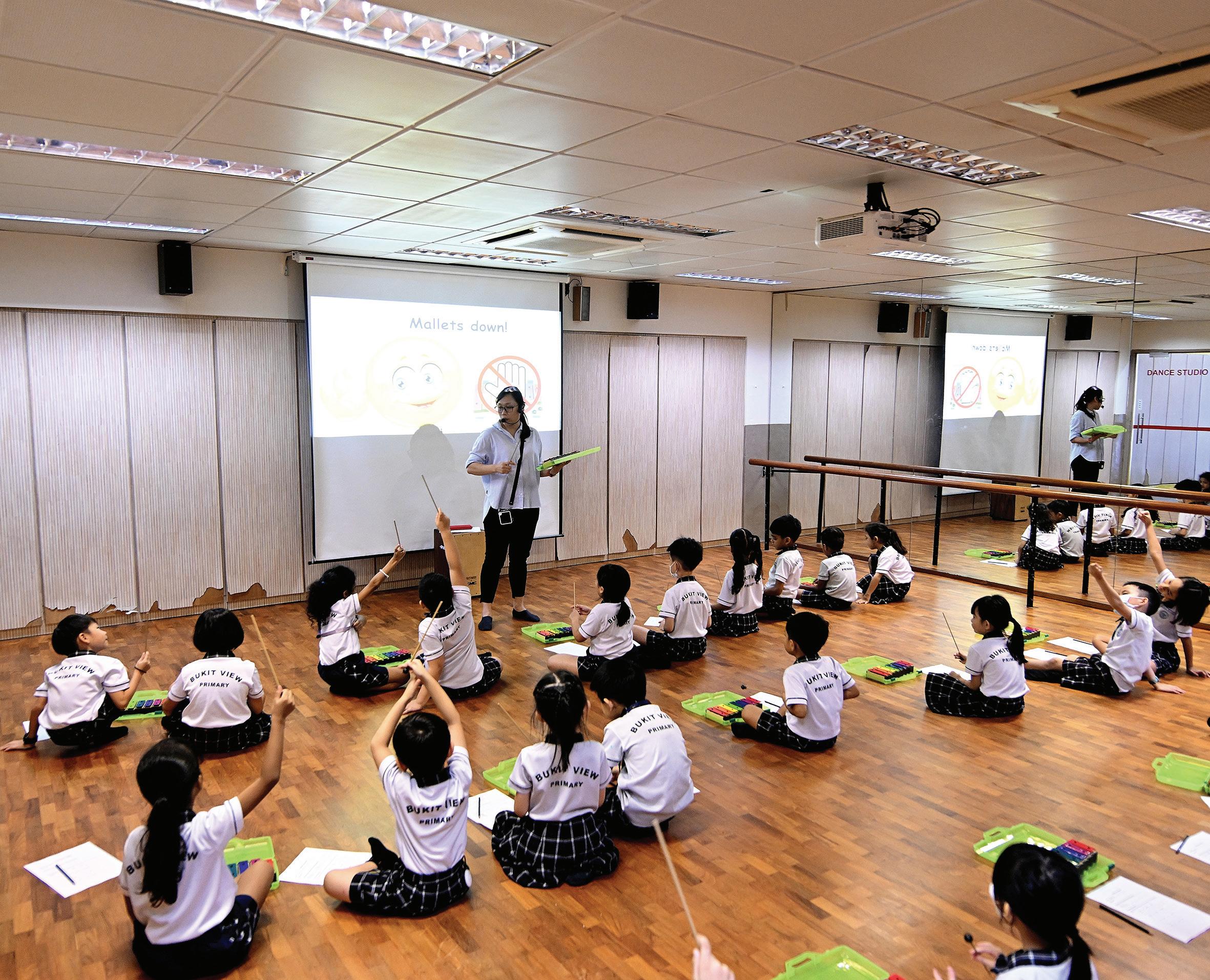
I also believe that students’ learnings should hold significance for them. This begins with me discovering students’ preferences and interests, and empowering them to take ownership of their learning in their areas of interest. Although this takes time and effort, it is all well worthwhile. Witnessing the spark of realisation in their eyes when they exclaim, “A-ha, I can do it!” is truly heart-warming.
Over the past four years, I have been grappling with what my music lessons should look like. I found these handles useful in trying to do so:
1. I try to create lessons that are a bit more experiential, so that there is always some element of music-making involved. My students are most engaged when they can experience the joy of making music through their own skills and creativity.
2. I try to equip my students with a foundation which they can build on if they wish to pursue music as a career. For example, I realised that using a DAW has become a fundamental skill set, so I experimented with how to teach these skills although I was completely unfamiliar with how to use a DAW myself.

3. To help my students connect with music, I first need to connect with music myself. Very often I forget that I am a musician, and unfortunately it is very easy to lose my own connection with music amidst the business of carrying out my responsibilities as a teacher.
My attempts to help my students connect with music is definitely still a work in progress, but I urge us not to forget how music connects with us too.
HOW CAN WE UPLIFT AND EMPOWER OUR COMMUNITIES TO DO THE SAME?
5-min read
Atika Naim
Northlight School
The story begins with igniting one’s musical imagination when watching a film clip without audio. Atika leveraged on this clip as a stimulus for students to identify emotions in the film scene, which would help them to imagine what the accompanying music may sound like. Thereafter, students listened to the actual soundtrack and articulated how the musical elements conveyed the intended emotions. Students ‘triggered’ their imaginative spirit into creating a 12-bar arrangement (using a Digital Audio Workstation) for a 33-second film clip. The curriculum further evolved into integrating and arranging music to enhance the dramatisation of the students’ drama performances (in the drama curriculum). Atika’s project had an impact beyond the interdisciplinary aspects of combining music and drama. Students were challenged to develop negotiation and collaborative skills, to be more self-directed in their learning, and exercise decision-making skills. Thus, making this project a great opportunity for the integration of values education through the arts.

Desmond Seah & Angelina Tan
Jiemin Primary School
In their endeavours to create a classroom that can maximise learning efficiency of their students, Desmond and Angelina developed an imaginative approach that would respond to the students’ readiness and learning profiles. For example, instead of typically having the students choose different songs of various difficulty levels, the approach was to play the same song but tiered from ‘simple to complex’ (10 levels). This enabled differentiation according to readiness which encouraged students’ engagement and motivation. They highlighted that it was important for students to demonstrate their growth through their learning processes instead of aiming to complete the most challenging task.
Check Out
meaningful assignments to ignite their students’ engagement.
Reflecting on the TCEF Spotlight by Professor Lee Higgins (York St John University, UK)
5-min read
In his Spotlight address, Dr Higgins shared that community music is about people, places, participation, inclusion, and diversity.
People
Community music places participants alongside community musicians as co-authors and collaborators, encouraging them to journey together towards transformative musical experiences.
Places
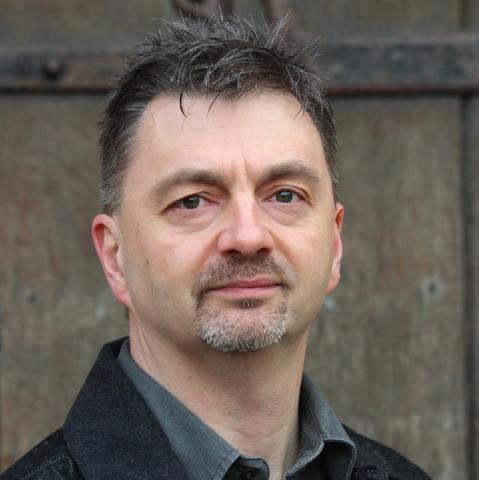
The context in which community music happens is very important.
Participation
Community musicians create platforms for active music, and seek to increase accessible pathways that lead towards meaningful musical engagement.
Inclusivity
Community music challenges dominant cultural hierarchies in order to include all musics and expressions. It believes that everyone has a right to produce and practise culture, not just consume or conserve it.
Diversity
Diversity is integral to community music, as it is about the celebration of difference.
Community music is fundamentally about relationships. Community music may be viewed as an act of hospitality, where participants are welcomed to participate in musicking. The welcome can be understood as an open invitation to build relationships with others.
The simple act of saying ‘yes’ to the welcome requires a conscious decision, and provides the opportunity for the welcome to be made wholeheartedly. It suggests that by reaching out beyond what may be thought possible, new and interesting things can happen.
Hospitality also alerts us to power imbalances within human relationships. On one hand, there are aspirations for the music facilitator to relinquish control, ensuring creative ownership and a sense of equality, whilst on the other, music facilitators are in a position of power and as such have responsibilities.
Through non-formal learning, both teachers and students collaboratively decide what the learning outcomes should be. Informal learning on the other hand, “is informed by the ways in which popular musicians direct their own learning outside school” (STAR, 2020, p. 25).
Community musicians engage in non-formal learning, where there is a music leader who facilitates the music making. Non-formal learning is a kind of listening activity. It is a dialogue; a conversation. Thus, the idea of listening, both as a musical activity and as a form of cultural democracy, is of utmost importance in community music.
However, as music teachers, we are rarely engaged in only one form of teaching and learning; instead, we are engaged in and across a continuum that includes formal, non-formal and informal learning.
NON-FORMAL LEARNING IS A KIND OF LISTENING ACTIVITY. IT IS A DIALOGUE; A CONVERSATION.
Here is an example of what a continuum of informal, non-formal, and formal teaching and learning could look like. This diagram was presented by Dr Higgins during his Spotlight session. In this example, students are rehearsing as a pop band after school to prepare for their final assessment.
Context / location Interactions within the group are informal.
Teacher / facilitator / leader
Structure / planned
Document / assessment
Intent
Time
Aims/goals
Questions: Interactions within the group are informal.
There is a general rehearsal structure, but this could evolve as it progresses.
There is a general rehearsal structure, but this could evolve as it progresses.
The group leader facilitating the rehearsal provides nonformal guidance.
The group leader facilitating the rehearsal provides nonformal guidance.
Assessment and intent are more formal since students are working towards a final assessment.
Assessment and intent are more formal since students are working towards a final assessment.
There is a planned duration for the rehearsal, but this is flexible.
There is a planned duration for the rehearsal, but this is flexible.
There are nonformal aims for which aspects of their performance students want to improve.
There are non-formal aims for which aspects of their performance students want to improve.
• As teachers, do we similarly face difficulties in navigating power imbalances in the music classroom?
• What does the informal - non-formal - formal continuum in our classrooms look like?
• What do we want it to look like?
Read on to learn about how Friends-In-Concert 2023 continues to grow music teacher identities through community music-making.

5-min read
After three years of online performances, Friends In Concert (FIC) 2023 returned to live performances! We were honoured to be one of the first performers at a new performance space, and the new home of the library@Esplanade - the National Library Building (NLB). Our evening soirée on 25 August 2023 featured a total of thirty performers from twenty-two different schools.
As Dr Lee Higgins shared, community music is a celebration of difference (p. 16). Why can’t FIC similarly serve as an inclusive platform for our music fraternity to practise and consume a diverse array of musical genres and cultures? How can FIC be a platform that can empower every member of our community? We thus decided to be more intentional about encouraging musical genres that did not previously have as much visibility in past FICs, such as Western Classical Music, Asian Ensemble Music, and Jazz. We are proud to announce that with FIC 2023, we have made an important statement in this regard, and have broken important new barriers for FIC.

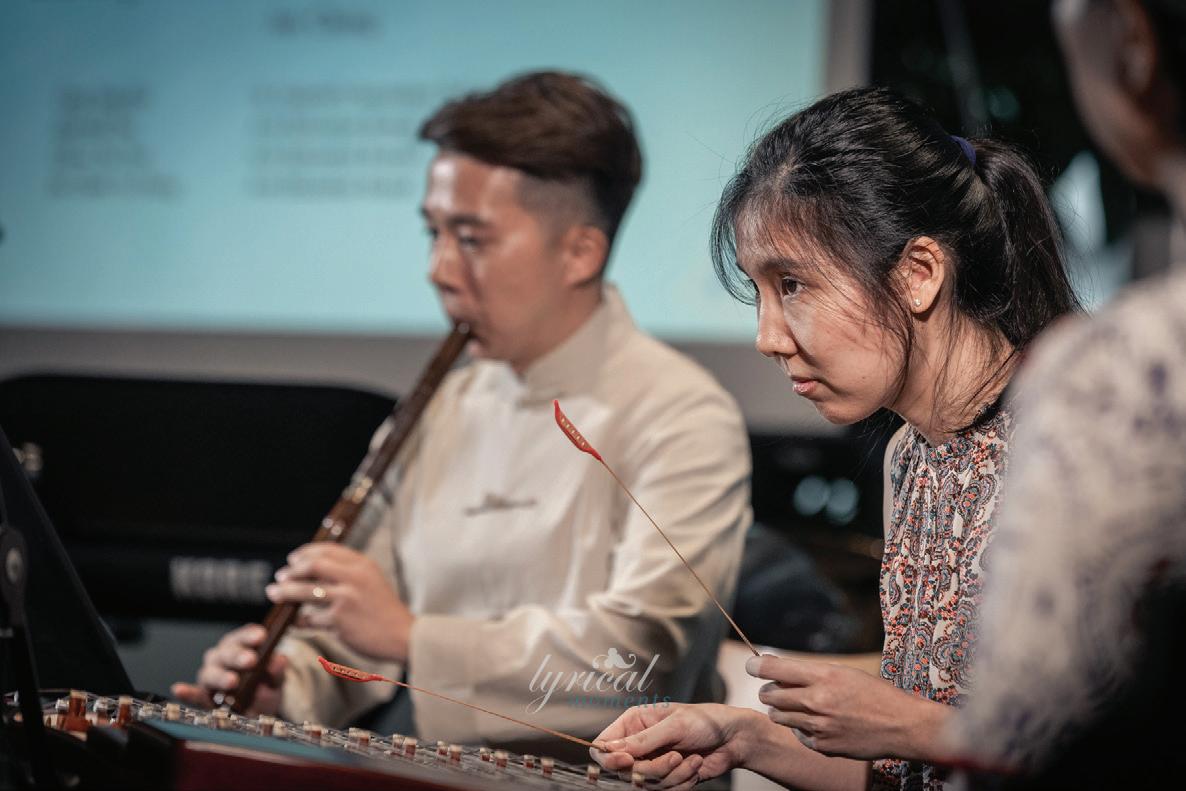
Teacher-musicians’ identities are informed by their past experiences, such as casual or formal training and personal musical interests. Ong Ting Kai, a member of the Asian Ensemble, shared that performing in FIC as a xiao player was a way for him to advocate for his identity with Asian music, and renew and affirm his roots in traditional Chinese Music. Being able to perform with like-minded teacher-musicians brought him much joy, and the experiences became additional stories and learnings that he is excited to take back to share with his students and colleagues in school.



This year, our teacher-musicians once again had the privilege of working with industry mentors who are highly accomplished in their respective fields of expertise. Different industry mentors were assigned to different musical groups based on their expertise; Mr Ng Seng Hong for the Asian Ensemble, Mr Ang Chek Meng for the Classical Ensemble, Mr Goh Kheng Loong for the pop bands, and Mr Peter Huang and Ms Calin Wong from MICappella for the a cappella groups. Through their valuable inputs, teacher-musicians’ learnings were enriched with fresh perspectives, and they developed better performing skills and strengthened their love for music.
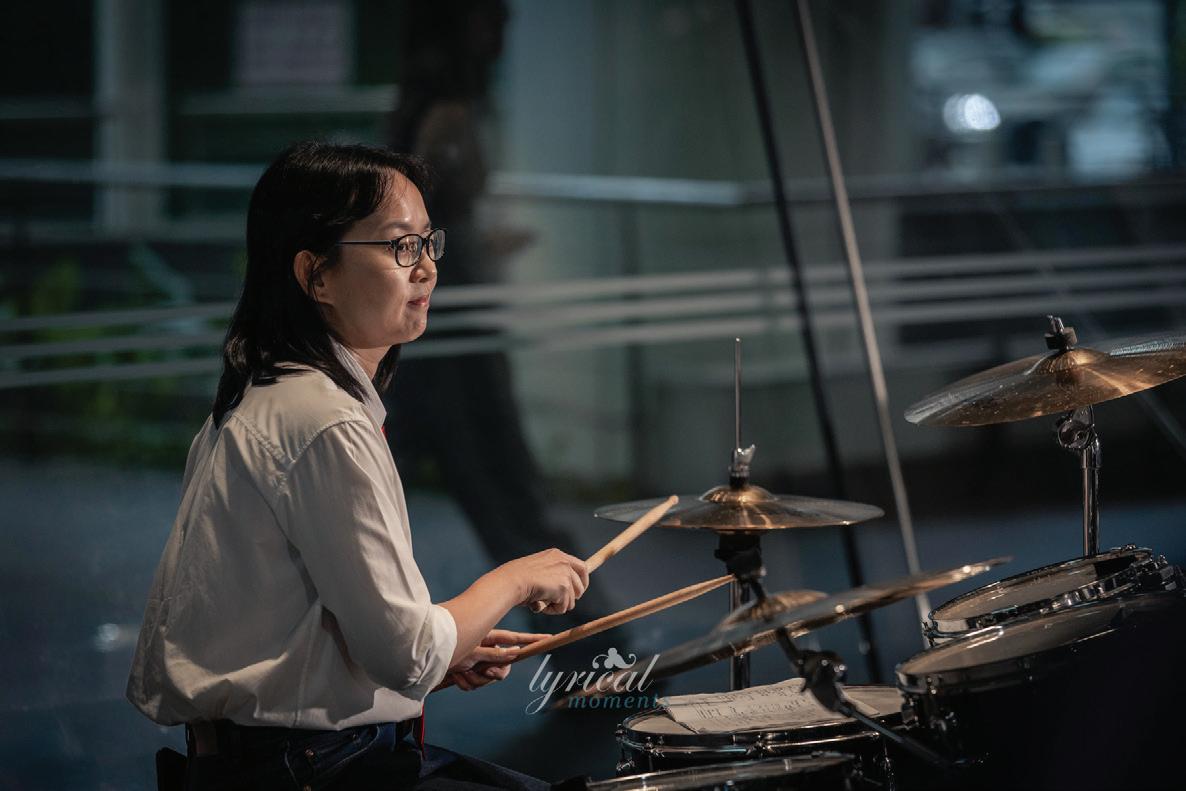

Music teacher and pop band drummer Tan Shi Ying felt that the session with renowned music director, Mr Goh Kheng Loong, was extremely rewarding as he provided feedback to further improve and shape her band’s arrangement. In spite of Shi Ying’s limited technical skills as a firsttime drummer, Mr Goh provided her with precise feedback to help create different textures in different sections of the song to enhance the band’s arrangement.
MICappella helped the group look into multiple aspects of the performance - from musical techniques and details in phrasing to stage choreography and confidence. They also worked on developing a more cohesive ensemble sound so that their voices blended better with one another.
FIC 2023 also broke new ground in encouraging greater community building among the FIC community. The “Teacher Friend” is a novel idea that was introduced for FIC 2023. Teacher-friends are past FIC participants who have considerable expertise in the musical genre of the FIC group they journeyed with. They serve as a supportive, knowledgeable “other” and provide a critical

ear for the group. The intent of the Teacher Friend is also to strengthen the FIC ecosystem, and provide greater encouragement and opportunities for social and community exchanges. Because of the good rapport built, the teacher-musicians felt comfortable to share their difficulties in the music and were open to inputs from their teacher-friend.
THE INTENT OF THE TEACHER FRIEND IS ALSO TO STRENGTHEN THE FIC ECOSYSTEM, AND PROVIDE GREATER ENCOURAGEMENT AND OPPORTUNITIES FOR SOCIAL AND COMMUNITY EXCHANGES
Priscilla Pan, teacher-friend for one of the a cappella groups, used technology to help provide accurate feedback to the singers - she videoed the group’s run throughs of the repertoire and then played the videos back for her members to review their singing techniques, voice blending, music dynamics, phrasing, and even the group’s stage blocking. She then facilitated discussions on possible strategies for the areas for improvement. The singers were highly engaged in this process and deeply invested in their rehearsals for the performance.

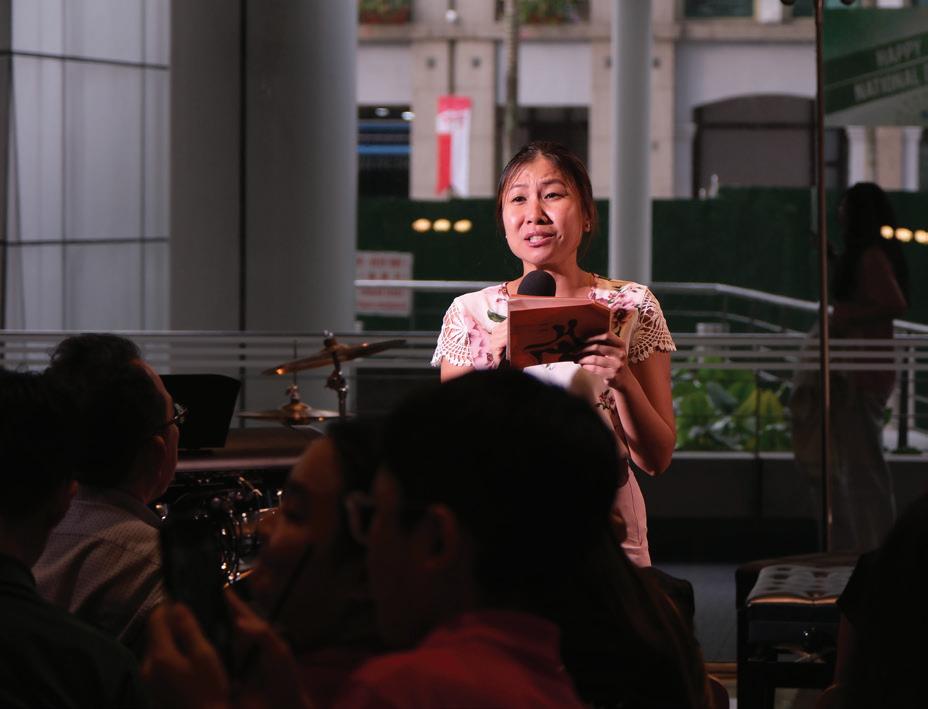
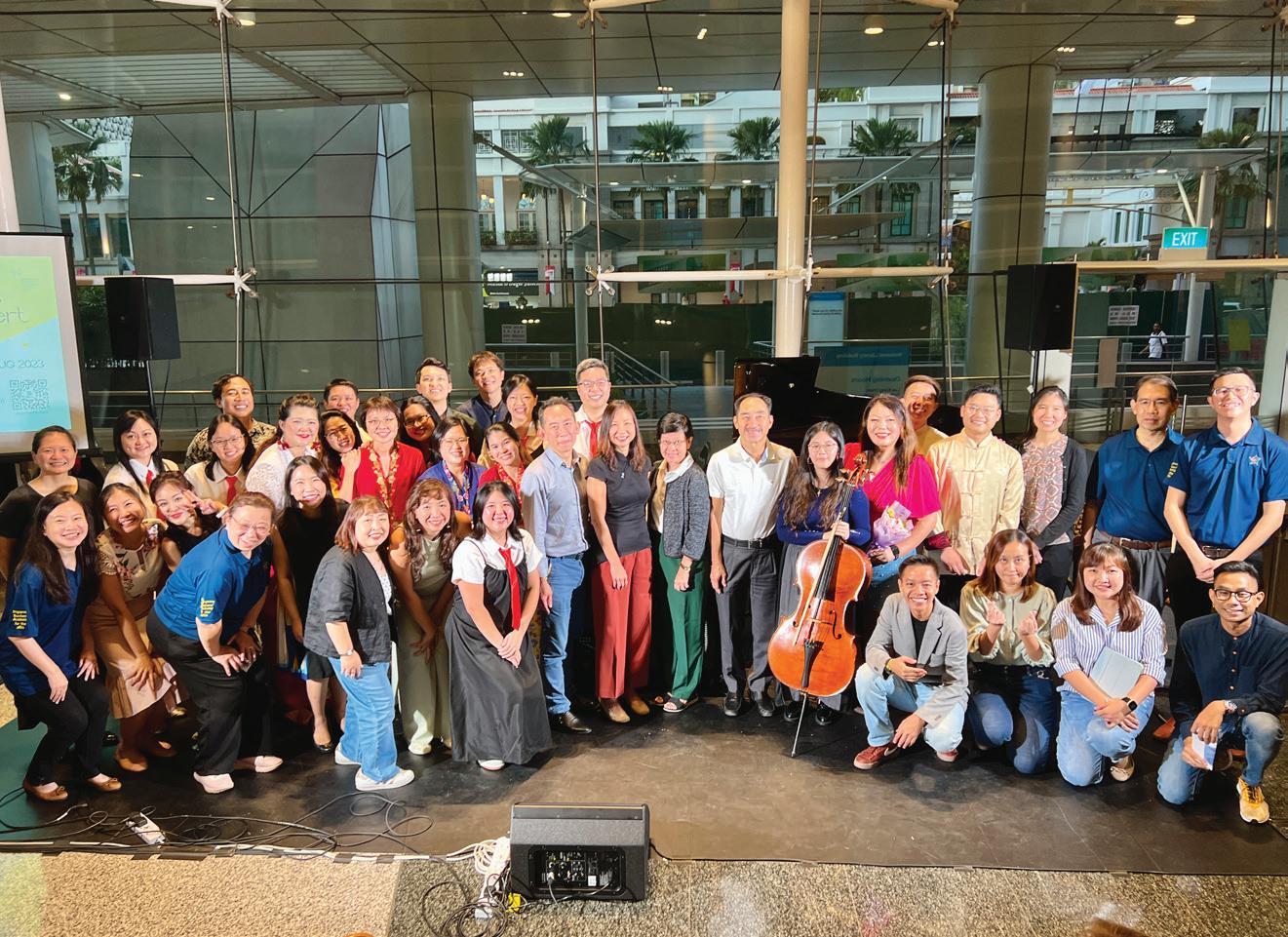
STAR would like to extend our heartiest congratulations to all teacher-friends and teacher-musicians who participated in FIC 2023. Stay tuned for the FIC 2024 open call!

5-min read
Let’s ‘Samba’ with Inquiry-based Learning!
Grace Lee Casuarina Primary School
How can an Inquiry-Based Learning approach increase students’ engagement and empower them to take charge of their own learning? It began with Grace leveraging on Bybee and Landes’s 5E Instructional Model (Engage-Explore-ExplainElaborate-Evaluate) for Inquiry-Based Learning (1990) to facilitate the co-construction of knowledge and skills in a community setting. This collaborative approach empowered students to learn through experimentation and self-directed discovery.
Students started with viewing a samba performance video and they generated questions based on what they had observed about the performance [Engage], after which, students searched for the answers to their questions [Explore]. The collation of the answers they discovered as a community [Explain] allowed them to deepen their learning by creating a performance [Elaborate]. This ended with their reflection on their groups’ performances [Evaluate].
The collaborative and inquiry process as a community enabled the students to develop intrinsic motivation and empower self-directed learning.
Michelle Yap
Lee Siu Marn
Janet Heng
Serena Chew
Fairfield Methodist School (Primary)
The idea of forming virtual instrument bands with the use of iPads was with the intent to foster collaborative music-making in their Primary 5 classrooms. The music teachers from Fairfield Methodist School (Primary) wanted to empower the students to begin with self-directed learning through an ‘express and experiment station learning’ approach. After which, the students would collaborate in small groups to perform the song. Within each group, they would combine their knowledge to create their iPad Band performance. This approach had inspired students of all backgrounds to engage with community music-making. Leveraging on these shared experiences and values, a safe environment for collaborative learning was created in the music classroom.

3-min read
What have we learned about transformation so far in this issue of STAR-Post?
In Dr Pamela Burnard sharing (p. 8–9), we learned how including environments, places, spaces and objects in pedagogy can offer transformative possibilities.
In Dr Lee Higgins’s sharing (p. 16–17), we learned that participants of community music are encouraged to journey together towards transformative musical experiences.
From these, it seems that igniting imagination and empowering communities may involve or lead to transformation. Therefore, it may be important for us to consider, what is transformation, and what can it look like?
Inspired by Clover and Stalker’s (2007) and Sidebottom’s (2019) suggestions that art-based reflective practice could provoke and affirm creative visions of alternative worlds, we asked teachers to draw their responses to the question, “What does transformation mean to you?”. Let’s see what they think.
Gin Chua Waterway Primary School
The delicate and careful craft of cutting rock mineral into a diamond relates to how music educators carefully plan and craft the “best” musical experiences for their students. In turn, students hone their inspirations, knowledge and passion to transform and emit a colourful glow, sparkling in their own unique ways.

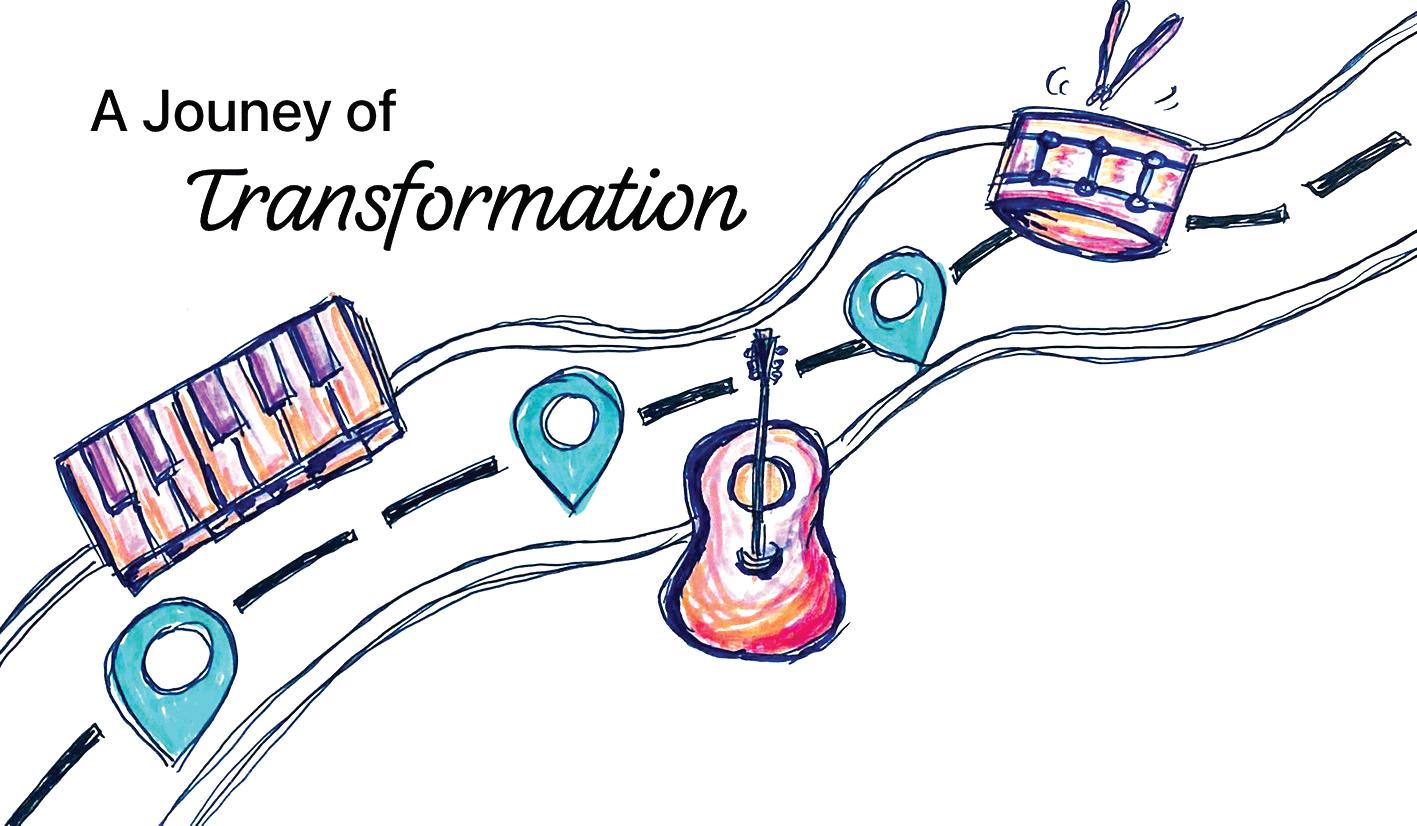
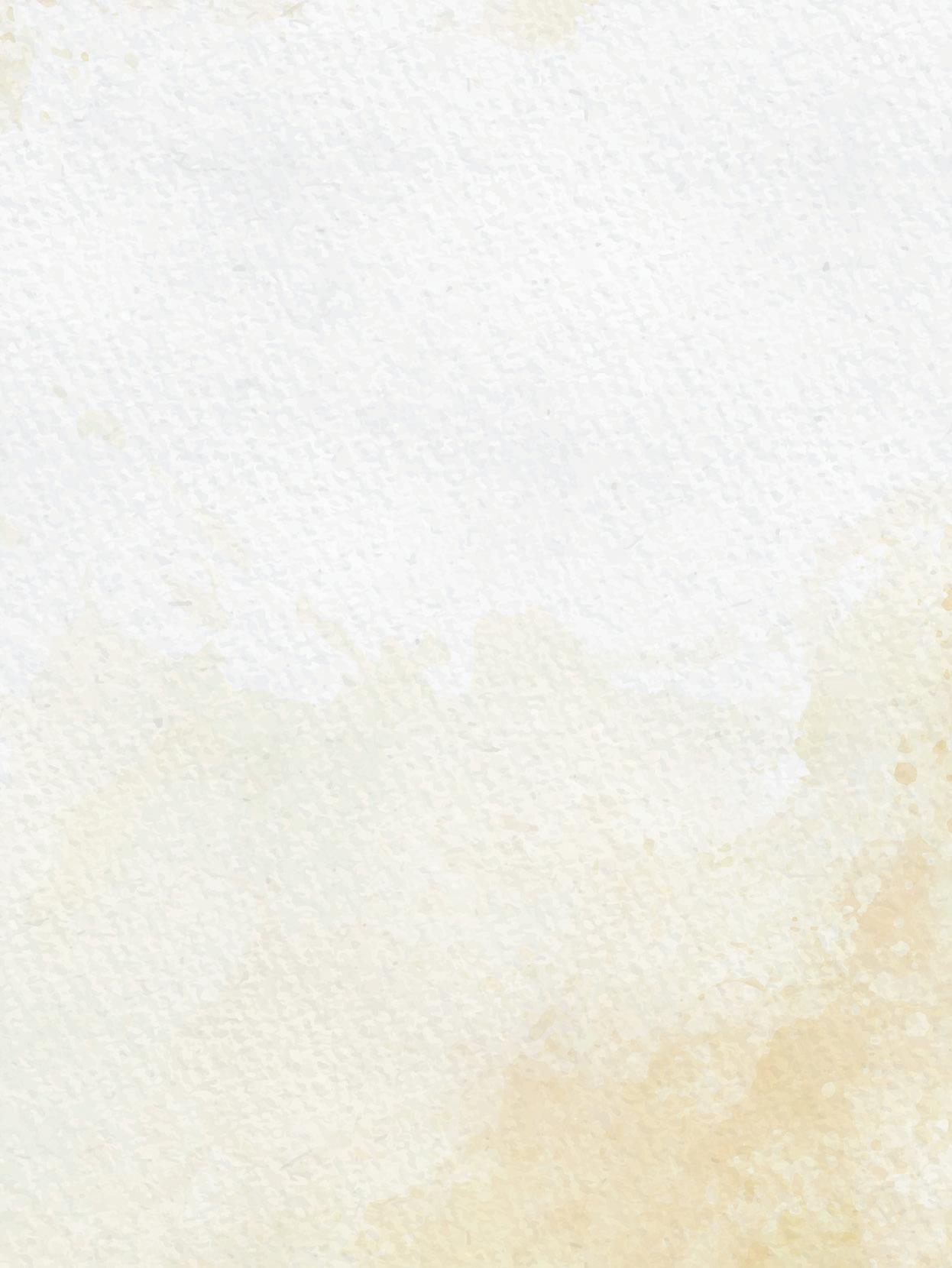
Jwen Lim Woodgrove Secondary School
Every student’s musical learning is a journey that evolves over time. Through music education, students are transformed into active team players who are resilient, innovative, self-directed, and confident. Providing students with opportunities to showcase and experience the power of music allows them to reap the transformational benefits of a quality music education.
Transformation is sometimes thought of as something with a dramatic impact, but like the evolution of colours in a colour wheel, it can begin with very basic ideas. As we aspire to facilitate big ideas, learning experiences and musical engagements, let’s not underestimate what we can achieve from taking small steps in our music classrooms. As ideas fuse and grow, we will see the explosion of colours, which can be transformational for others through reflection.


My student’s learning space is transformed many times throughout the lesson. They are empowered to choose who they would like to sit or group with and are encouraged to work with different classmates each time. This fluid and dynamic classroom intentionally creates opportunities for different types of social interaction to forge meaningful relationships while musicking.

Joanne Tay Anderson Primary School
In the heart of an ancient, whispering tree, A grand piano dreams so wild and free. Autumn leaves like music notes fall, Nature and melody response and call.
Educator’s legacy, a story so profound, Sowing seeds where knowledge is found. Trees where guardians of futures untold, From roots to keys, transformation unfolds.
A symphony in each ripple of sound, Touching souls where love is found. In music’s language, boundaries fade, Uniting mankind in melodies made.
This tale of transformation, a cosmic birth, Nurtures minds and connects souls. In the song’s echo, we find our space, Education’s magic, in every embrace.

We hope our teachers’ reflections have ignited your imaginations and empowered you to consider how your own transformation would look like.
We leave you three final questions to consider:
WHAT KIND OF CHANGE IS CONSIDERED TRANSFORMATIVE?
HOW CAN MUSIC EDUCATION BE TRANSFORMATIVE?
And above all,
HOW CAN WE TRANSFORM PRACTICE TO IGNITE IMAGINATION AND EMPOWER COMMUNITIES?
Teachers conducting table presentations at the N(T) Level Music NLC.
Participants attempting to do a recording of a song at the ICT Module on facilitating technologicallymediated performances.

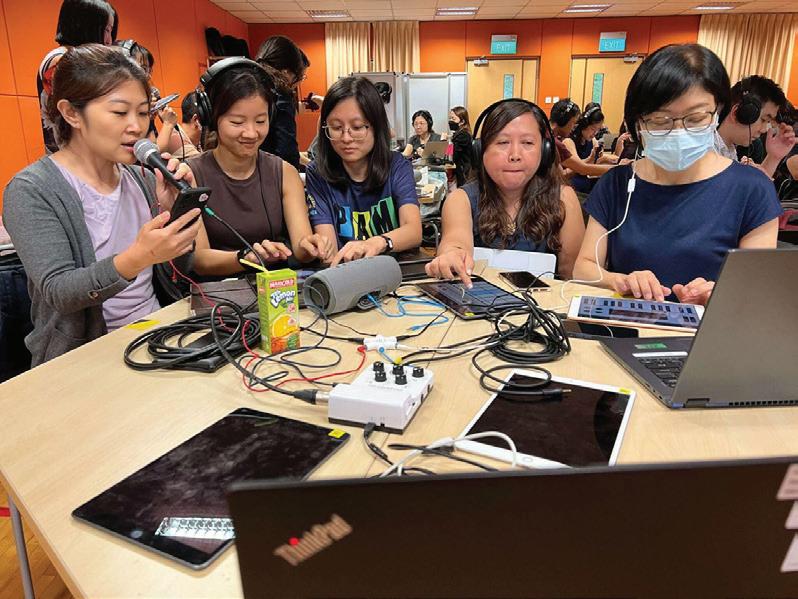

Primary school teachers recording a music game they learnt at the Music BT Programme.

Participants showcasing their rhythmic creation for a music-making activity at the West Zone Primary STAR Champions’s sharing.
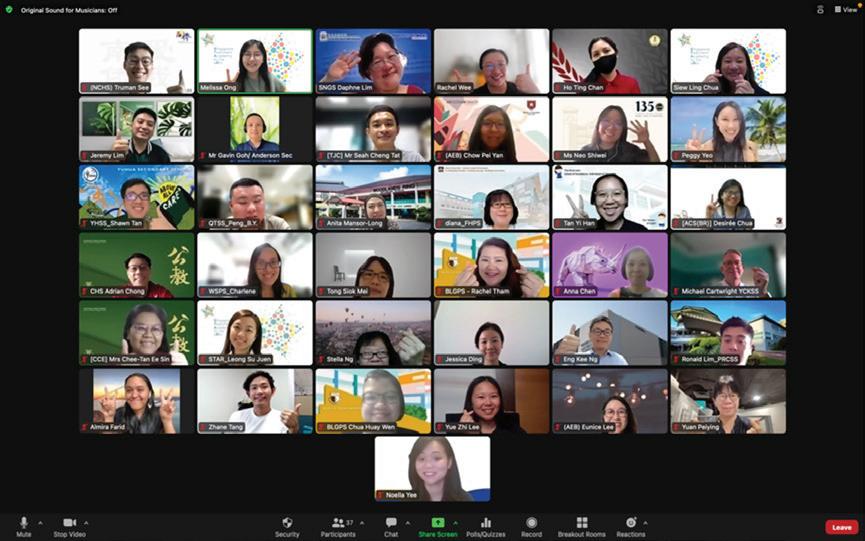
Participants celebrating rich conversations and learnings at the Critical Inquiry NLC Mini Symposium. 03

Lee Ley Har
Deputy Director (Music)
Lee_Ley_Har@moe.gov.sg
+65 6664 1558
Chua Siew Ling
Principal Master Teacher (Music)
Chua_Siew_Ling@moe.gov.sg
+65 6664 1554
Li Yen See
Master Teacher (Music)
Chan_Yen_See@moe.gov.sg
+65 6664 1499
Suriati Bte Suradi
Master Teacher (Music)
Suriati_Suradi@moe.gov.sg
+65 6664 1498
Ong Shi Ching Melissa
Academy Officer (Music)
Melissa_Ong@moe.gov.sg
+65 6664 1495
Kelly Tang
Master Teacher (Music)
Kelly_Tang@moe.gov.sg
+65 6664 1561
Leong Su Juen
Academy Officer (Music)
Leong_Su_Juen@moe.gov.sg
+65 6664 1494
Toh Sze Hui, Felicia
Academy Officer (Music)
Felicia_Toh@moe.gov.sg
+65 6664 1555